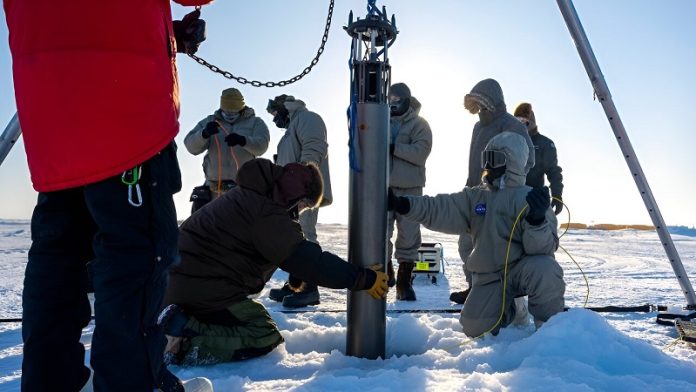
In the icy waters of the Beaufort Sea, north of Alaska, a team of engineers from NASA’s Jet Propulsion Laboratory (JPL) gathered around a small hole in the thick sea ice.
They were testing a cylindrical robot that had been lowered into the frigid ocean below.
This test marked an important step in a project called IceNode, which aims to develop a fleet of autonomous robots capable of exploring the mysterious, melting ice shelves in Antarctica.
The main goal of IceNode is to help scientists understand how quickly Antarctica’s ice is melting and how this could contribute to rising sea levels.
Antarctica’s ice sheet is massive, and if it were to melt completely, it could raise global sea levels by about 200 feet (60 meters).
This would have a profound impact on coastal areas around the world. Scientists know that warming ocean waters are a major factor in this melting, but they need more accurate data to predict how fast it is happening.
One of the biggest challenges in studying Antarctic ice is that the areas where melting occurs most rapidly are incredibly difficult to reach.
These include underwater areas where the floating ice shelves meet the ocean and the land beneath.
This region, known as the “grounding zone,” is often located under miles of ice, making it nearly impossible for humans to access. Satellites can’t see into these deep underwater cavities, so a different approach is needed.
This is where IceNode comes in. The engineers at JPL are developing robots about 8 feet (2.4 meters) long and 10 inches (25 centimeters) in diameter.
These robots are designed to travel deep beneath the ice shelves and collect critical data on how warm ocean water is melting the ice. The robots have three-legged “landing gear” that allows them to attach to the underside of the ice, where they can monitor the melting process.
What makes these robots unique is that they don’t have any propulsion system. Instead, they use advanced software that helps them navigate ocean currents to reach their target locations. Once there, the robots drop their ballast, allowing them to rise and attach to the ice above.
They can then measure how warm, salty ocean water interacts with the ice and how the resulting cold, fresh meltwater behaves.
The IceNode robots are designed to operate for up to a year, gathering data continuously, including information on seasonal changes. After their mission is complete, the robots will detach from the ice, drift back to the open ocean, and send their data to scientists via satellite.
The recent test in the Beaufort Sea, conducted in March 2024, was the first time the prototype was tested in a polar environment.
The test was part of the U.S. Navy Arctic Submarine Laboratory’s Ice Camp, a three-week operation that provided a base for researchers to work in the harsh Arctic conditions, where temperatures dropped to minus 50 degrees Fahrenheit (minus 45 Celsius).
During the test, the robot successfully gathered data on salinity, temperature, and water flow as it descended about 330 feet (100 meters) into the ocean. The team also identified areas for improvement to prepare the robot for future untethered missions.
“We’re pleased with the progress we’ve made,” said Paul Glick, a JPL robotics engineer and the principal investigator for IceNode. “Our goal is to continue developing these prototypes, test them further in the Arctic, and eventually deploy a full fleet under Antarctic ice shelves.
The data we gather will be invaluable for scientists studying climate change and sea level rise. Every step forward in this project brings us closer to that goal, and it’s very exciting.”
Source: NASA.



